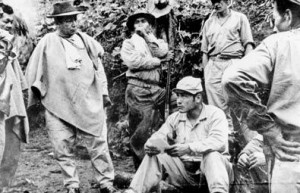 After five months, the Colombian government peace negotiations with the Revolutionary Armed Forces of Colombia (FARC) in Havana are still on the first—and most complicated—item of their five-point negotiating agenda: the restructuring of rural development. Things are moving slowly but steadily, with the government saying they’ve already hammered out a few pages of an agreement. One of the FARC’s main proposals has caused a stir (though it’s unclear how controversial it is at the negotiating table). A central point of the FARC’s proposal is a call for nine million hectares of land—an area approaching the size of Portugal—to be converted into Campesino Reserve Zones (Zonas de Reserva Campesina or ZRC). What’s raised howls from right-wing opponents is the FARC’s suggestion that these ZRCs be given a legal status similar to that of indigenous reserves and Afro-Colombian collective property (i.e. a degree of administrative autonomy). So at this stage the talks hinge on a question of political geography.
After five months, the Colombian government peace negotiations with the Revolutionary Armed Forces of Colombia (FARC) in Havana are still on the first—and most complicated—item of their five-point negotiating agenda: the restructuring of rural development. Things are moving slowly but steadily, with the government saying they’ve already hammered out a few pages of an agreement. One of the FARC’s main proposals has caused a stir (though it’s unclear how controversial it is at the negotiating table). A central point of the FARC’s proposal is a call for nine million hectares of land—an area approaching the size of Portugal—to be converted into Campesino Reserve Zones (Zonas de Reserva Campesina or ZRC). What’s raised howls from right-wing opponents is the FARC’s suggestion that these ZRCs be given a legal status similar to that of indigenous reserves and Afro-Colombian collective property (i.e. a degree of administrative autonomy). So at this stage the talks hinge on a question of political geography.
Legislation for Zonas de Reserva Campesina (ZRC) has been on the books since 1994. Colombia currently has six separate ZRCs comprising a total of 831,000 hectares—an area almost as big as Cyprus. (Colombia is not the only Latin American country to have experimented with campesino reserves.) But the FARC’s vision for the ZRCs is that they gain a degree of administrative autonomy—something indigenous and Afro-Colombian collective titles already have. This would essentially give the ZRCs more political, administrative, and fiscal power—the latter, through government budget transfers. In simple terms, think of it like the creation of a new municipal government, but just spread over a bigger swath of land—land which would be legally inalienable from its collective owners. The FARC has backed calls for the creation of 50 new ZRCs comprising a total of nine million hectares.
This has immediately drawn condemnation from landowners, right-wingers, and the current Minister of Agriculture Juan Camilo Restrepo (who is not at the table in Havana). Restrepo has repeatedly said the FARC’s proposal is tantamount to the balkanization of the country through the creation of “Repúblicas Independientes” or “republiquetas” (mini-republics). The terms are extremely loaded with a tremendous amount of historical baggage. During Colombia’s civil war in the 1950s, Colombian Senator Álvaro Gómez Hurtado claimed that campesino communities were establishing Repúblicas Independientes that “do not recognize the sovereignty of the state” with the help of communist rebels (not yet the FARC). The FARC’s “founding moment” came when the government began bombing those autonomous peasant communities stigmatized as Repúblicas Independientes.

Nine million hectares may sound like a lot and it might appear to give Restrepo’s assertions some weight, but sociologist Alfredo Molano helps put things into perspective. He notes campesinos have been violently forced off of six million hectares of land through the course of the war. And cattle ranching, which is dominated by large landowners, currently takes up 34.5 million hectares—a highly unproductive industry that creates little rural employment. Molano also adds that the country still has 1.5 million hectares of untitled land (called baldíos). The FARC proposes that the nine million hectares for the ZRCs come from government buyouts of unproductive land and baldíos.
The FARC’s demand for the ZRC opens like this: “Recognition and demarcation of campesino territories and territorialities, including the rights of campesino communities along with the valorization and political recognition of the peasantry.” The ZRC would be the material basis for the FARC’s demand for the “re-establishment of the dignity and recognition of peasants as political subjects, with guarantees and full enjoyment of their political, economic, social, and cultural rights as well as the corresponding provision of budgetary resources and infrastructure.” This is actually not far from the current ZRC legislation on the books.
Opponents fear that the ZRC will become territories beyond state control. But leaders in already existing ZRCs say that the zones themselves are a product of “state absence” created out of “pure necessity” in order to gain some recognition from the state. Peasant communities can band together and petition the government for the creation of a ZRC. Upon approval of the communities’ petition, which is required to include a development plan, the size of land holdings are limited within the ZRC and the government is required to provide the zone with state assistance (which it rarely has).
The FARC’s plan would essentially create 50 of these zones by fiat. Besides the number and size of the ZRCs proposed by the FARC, the main sticking point in Havana is likely to be how their political administration would fit within the country’s decentralized territorial ordering.
I see no reason why they couldn’t borrow from the legislation regulating indigenous and Afro-Colombian territories and adapt it to the law on the ZRCs. This would be a major development: a non-racialized/ethnicized recognition of autonomous territorial rights.
[Correction: The post originally credited the term “Repúblicas Independientes” to a “government minister,” but Álvaro Gómez Hurtado was in fact a Senator. Thanks to @RAKarl for pointing out the error.]

Thanks for this update. Very interesting. You say that ZRCs would potentially be “non-racialized/ethnicized” territorial rights, but as an unmarked ethnicity would they not then effectively be white-mestizo? Additionally, considering the (violent) relationship of the FARC to indigenous and afro-communities?
Thanks for the comment Devin. What you point out about white/mestizo is true. What I meant is that the claim or recognition of the ZRC as a collective territory is not being made in that ethnic/racial register. And, yeah, it’s definitely ironic: as you point out, the FARC has in many cases been hostile toward Afro and indigenous groups with collective property. As they themselves suggest, there is a kind of appropriation going on.
Also, to complicate matters further: the campesinos in the zones would presumably be a diverse bunch spanning Colombia’s ethno-racial spectrum.
right, so much for a simple race hierarchy… Thanks for the discussion.